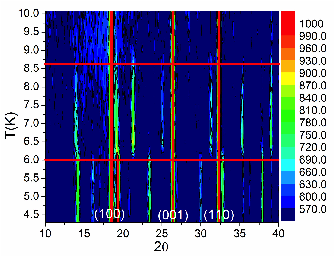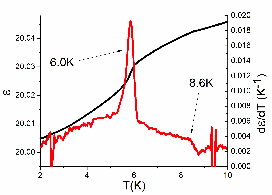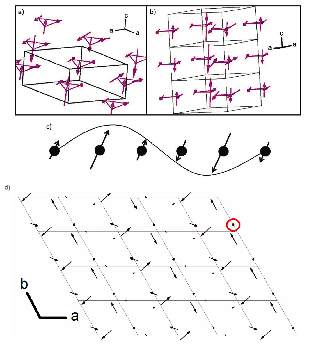57th Annual Report on Research 2012 Under Sponsorship of the ACS Petroleum Research Fund
Reports: UR1051374-UR10: New Multiferroics Based on 2D Frustrated Sublattices
Christopher R. Wiebe, BS, MSc, PhD, University of Winnipeg
The langasites have been a major focus of study in the last decade due to the variety of properties they exhibit including piezoelectricity in La3Ga5SiO14 [1], highly degenerate magnetic ground states in Pr3Ga5SiO14 [2], and multiferroicity in Ba3NbFe3Si2O14 [3]. The latter has been a particularly active area of research because of complex spin dynamics arising from chiral, helical antiferromagnetic ordering at TN= 26 K. The chirality introduced by the magnetic structure breaks symmetry, which allows this material to undergo a ferroelectric polarization [4]. Efforts to increase the multiferroic transition temperature by chemical substitution by other research groups have been unsuccessful; the Fe3+ cation occupies a tetrahedral site that other magnetic ions find unfavourable compared to the octahedral Nb5+ site.
We have undertaken the task of synthesizing new multiferroic compounds based upon this structural motif. Drawing on previous work from B.V. Mill [5], we have optimized a method to substitute Fe3+ for other magnetic cations by taking advantage of Te6+, which is only known to exist in octahedral coordination [6]. Te6+ has a high affinity for the Nb5+ site, forcing magnetic ions like Co2+, Mn2+, and Cu2+ into the tetrahedral site. We have recently synthesized isostructural compounds Pb3TeCo3V2O14 and Pb3TeCo3P2O14, members of the dugganite family. Both of these compounds have a series of magnetic transitions at low temperatures (near 8.0 K and 6.6 K) that are believed to be multiferroic in nature (that is, they involve both magnetic ordering and evidence for electric polarization). These are the first compounds beyond the Ba series that have been characterized. Although our efforts to increase the ordering temperature have failed, the underlying magnetic behavior of this system is unlike any other langasite studied thus far; the dugganite has two magnetic transition temperatures at TN1 = 8.6 K and TN2 = 6.0 K (Figure 1) more reminiscent of other Co‐V systems like Co3V2O8 and monoclinic Co2V2O7. A remarkable reordering of Co2+ moments occurs within a 2.6 K range. The first magnetic structure has a propagation vector k = (0.752, 0, 1/2) while the second has a propagation vector k = (5/6, 5/6, 1/2). While the second structure has been studied in detail, knowledge of the first structure remains rather limited, though recent work suggests this phase may contain a dynamic component – that is, there is only a partial ordering of the spins at low temperatures. The temperature dependence of the dielectric constant was measured to determine if this sample displays magnetoelectric coupling (figure 2). An anomaly can be seen at each magnetic transition temperature in both compounds. Thorough investigation of the structure yields two possible causes for these anomalies. Firstly, short V‐O distance along the c axis seen across all members of the dugganite series may introduce antiferroelectric ordering. An alternative explanation may be the dynamical nature of the first magnetic phase. Perhaps a preferred moment orientation exists in a dynamic row of Co2+ moments, which coexist with static ordered moments (figure 3). Further study is needed to confirm these findings.
We have also had recent success synthesizing new members of the langasite series that preserve the original langasite structure. Using the same strategy of the dugganite compounds, we prepared K3TeFe3P2O14, which has a much smaller lattice that Ba3NbFe3Si2O14. The transition temperature appears to be increased to 41 K in this material, due to the increased magnetic exchanged between the Fe3+ ions. Further tests are necessary to determine if the transition has a multiferroic origin.
Future studies include extending the Pb compounds to introduce other magnetic ions (such as Mn2+), single crystal growth of all of these materials by flux methods, and future testing of the multiferroic samples. This project has enabled the funding of 4 undergraduate students, with two of them completing undergraduate thesis projects as a direct result of this work. In addition, some of this work has been presented at major conferences such as the CSC in Calgary, Alberta earlier this year.
References
[1] H. Fritze, J. Electroceram. 26, 122 (2011).
[2] L.L. Lumata, T. Besara, P.L. Kuhns, A.P. Reyes, H.D. Zhou, C.R. Wiebe, L. Balicas, Y.J. Jo, J.S. Brooks, Y. Takano, M.J. Case, Y. Qiu, J.R.D. Copley, J.S. Gardner, K.Y. Choi, N.S. Dalal and M.J.R. Hoch, Phys. Rev. B 81, 224416 (2010).
[3] H.D. Zhou, L.L. Lumata, P.L Kuhns, A.P. Reyes, E.S. Choi, N.S. Dalal, J. Lu, Y.J. Jo, L. Balicas, J.S. Brooks and C.R.Wiebe, Chem. Mater. 21, 156 (2009).
[4] C. Stock, L.C. Chapon, A. Schneidewind, Y. Su, P.G.Radaelli, D.F. McMorrow, A. Bombardi, N. Lee and S.W. Cheong, Phys. Rev. B 83, 104426 (2011).
[5] B.V. Mill, Russ. J. Inorg. Chem. 54, 1205 (2009).
[6] A.E. Lam, An X‐ray Crystallographic Study of the Crystal Structures of Four Tellurium Oxysalt Minerals: Dugganite, Choloaite, Rodalquilarite, and Graemite. Dissertation, University of British Columbia, 1998.
[7] H.J. Silverstein, K. Cruz‐Kan, A.M. Hallas, H.D. Zhou, R.L. Donaberger, B.C. Hernden, M. Bieringer, E.S. Choi, J.M. Hwang, A.S. Wills and C.R. Wiebe, Chem. Mater. 24, 664 (2012).
Figure 1: Neutron diffractogram
contour plot showing two magnetic transition temperatures at 8.6 K and 6.0 K in
Pb3TeCo3V2O14. Diffuse scattering, indicative of
short-ranged ordering, appear at high temperatures [7].

Figure 2: The temperature dependence of the dielectric constant (black) shows anomalies at each of the transition temperatures. The first derivative of the dielectric constant (red) shows these anomalies more clearly. [7]
Figure 3: The magnetic structure of Pb3TeCo3V2O14 below 6 K shown from the (a) ab and (b) ac planes. The magnitude of the moment changes over 6 unit cells (c). An intermediate magnetic structure appears between 6.0 and 8.6 K that is illustrated in (d). An example of a dynamic spin is circled in red. [7]












